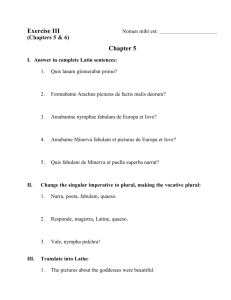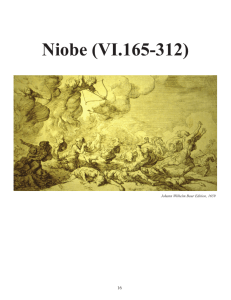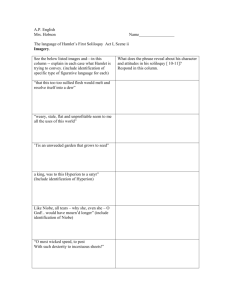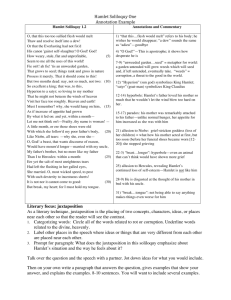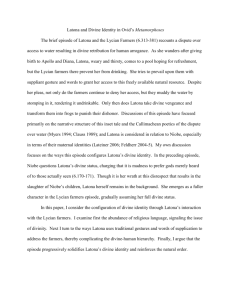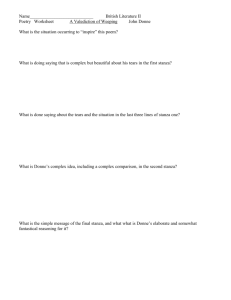Reviving The Statue: Early Modern Representations of the Myth of
advertisement
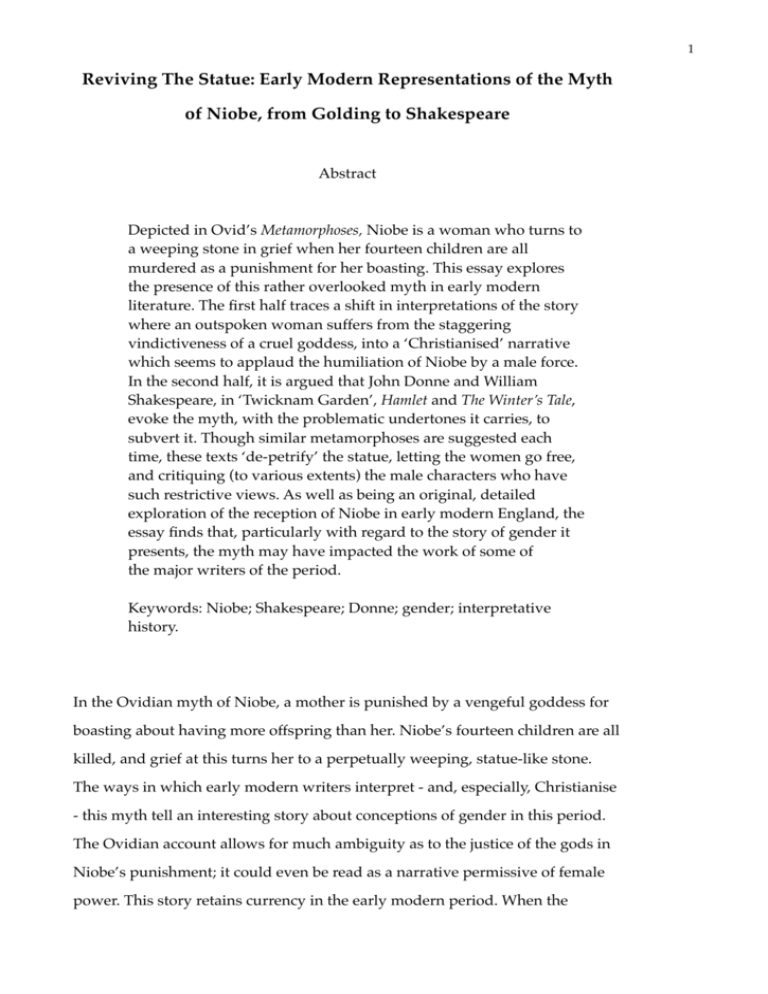
1 Reviving The Statue: Early Modern Representations of the Myth of Niobe, from Golding to Shakespeare Abstract Depicted in Ovid’s Metamorphoses, Niobe is a woman who turns to a weeping stone in grief when her fourteen children are all murdered as a punishment for her boasting. This essay explores the presence of this rather overlooked myth in early modern literature. The first half traces a shift in interpretations of the story where an outspoken woman suffers from the staggering vindictiveness of a cruel goddess, into a ‘Christianised’ narrative which seems to applaud the humiliation of Niobe by a male force. In the second half, it is argued that John Donne and William Shakespeare, in ‘Twicknam Garden’, Hamlet and The Winter’s Tale, evoke the myth, with the problematic undertones it carries, to subvert it. Though similar metamorphoses are suggested each time, these texts ‘de-petrify’ the statue, letting the women go free, and critiquing (to various extents) the male characters who have such restrictive views. As well as being an original, detailed exploration of the reception of Niobe in early modern England, the essay finds that, particularly with regard to the story of gender it presents, the myth may have impacted the work of some of the major writers of the period. Keywords: Niobe; Shakespeare; Donne; gender; interpretative history. In the Ovidian myth of Niobe, a mother is punished by a vengeful goddess for boasting about having more offspring than her. Niobe’s fourteen children are all killed, and grief at this turns her to a perpetually weeping, statue-like stone. The ways in which early modern writers interpret - and, especially, Christianise - this myth tell an interesting story about conceptions of gender in this period. The Ovidian account allows for much ambiguity as to the justice of the gods in Niobe’s punishment; it could even be read as a narrative permissive of female power. This story retains currency in the early modern period. When the 2 spiteful goddess is turned into a male, supposedly ‘good’ Christian God, however, the story is warped, even to the extent of being suggestive of a woman being punished for being strong, supposedly with divine authentication. " These two, conflicting but coexisting perspectives on Niobe, and the underlying views of women that the myth encompasses, resonate in the literature that evokes her, directly or indirectly. After outlining the varying attitudes to Niobe in early modern literature, this essay will look at three major texts in which the masculinist version of the myth is, arguably, evoked to be critiqued. In Donne’s ‘Twicknam Garden’, and Shakespeare’s Hamlet and The Winter’s Tale, to various extents, the female characters are vindicated, freed from their resemblances to suffering Niobe, and the men, who in all cases seem guilty, forced to have some sympathy. " Ovid’s Metamorphoses were ‘Englished’ by Arthur Golding, published in 1567. The popularity of Golding’s work in the early modern period means that it would probably have been a major source for the story of Niobe. This account depicts a strong, though flawed female character with relative verisimilitude. Niobe is somewhat at fault; she boasts that she has seven times as many children as the goddess Latona, and seems to think she is invulnerable. She has a kind of narcissistic pride in ‘The of-spring of hir selfe’.1 Yet this phrase may also highlight the significance of Niobe’s seeming status as an independent individual. Latona’s enraged decision to have all fourteen of Niobe’s children killed, is of course partisan, and disproportionately brutal. Alessandro Schiesaro writes that the Metamorphoses are situated ‘In a universe [...] in which the gods are mired in the same contradictions and partialities as humans’, and ‘knowledge can be entrusted only to a variety of accounts, fragmentary and biased as they inevitably are’. 2 The gods are not ‘just’. Niobe is said to pray for her last daughter, in Golding’s vocabulary, but ‘while she praid, for whom she 1 Arthur Golding, trans. The xv. Bookes of P. Ovidius Naso, Entitled, Metamorphosis, K5r. 2 Alessandro Schiesaro, ‘Ovid and the professional discourses of scholarship, religion, rhetoric’, 74. 3 praid was kild’.3 The close repetition of ‘praid’ next to the account of the brutal denial of her prayers drives home the suggestion that the gods are wilfully deaf to her requests - as well as, perhaps, suggesting that these women are not afraid to ‘prey’ upon one another. As William Drummond interprets, the children of ‘Wretched Niobe’ seem to have been ‘reft by heavens unjust’.4 Golding’s narrator does not condemn or belittle Niobe for her pride, but exclaims, at the end of the section: ‘Then all both men and women feare Latonas open ire’.5 " Latona’s actions are horrific, but her presence in the story as a mighty goddess means that the account is not closed to the idea of female power. Niobe is turned into a perpetually weeping stone on Mount Sipylus, but this demise can hardly be seen as a story of overconfident women being brought low. Latona’s terror earns her pride of place in Ben Jonson’s Fountaine of Selfe-Love, where she bathes with ‘her carelesse Nimphes,[...] In hourely pleasures’, and holds Niobe’s statue as ‘the proude Trophaee of her sharpe revenge’.6 " This ‘pagan’ account of Niobe’s story, as shown above, does have its respectable advocates in the early modern period: Ben Jonson; William Drummond; Arthur Golding. However, as Raphael Lyne suggests, the norm in adapting Ovid’s tales was to ‘Christianise’ them, giving them a moral.7 In 1592 Abraham Fraunce presented what may have been a more orthodox portrait of Niobe, in a compendium purporting to tell ‘the most conceited tales of the pagan gods in English hexameters together with their auncient descriptions and philosophicall explications’.8 In the hexameter Apollo (Latona’s son) is said to 3 Golding, K7v. 4 William Drummond, ‘Niobe’, Poems, P3v. 5 Golding, K7v. 6 Ben Jonson, The Fountaine of Selfe-love. Or Cynthia’s Revels [...], B4r-B4v. See Raphael Lyne, ‘Golding’s Englished Metamorphoses’, in Ovid’s Changing Worlds, 27-79, for an expansion of the moralising history of Englished metamorphoses until Golding’s work. 7 8 Abraham Fraunce,The third part of the Countesse of Pembrokes Yuychurch [...]. 4 have ‘Plagued prowd Niobe’ ‘worthily’.9 The ‘philosophicall explications’ are even harsher in moral condemnation: Niobe, for her excessiue pride and contempt of God, is worthily plagued, yea so extreamely plagued in those very thinges wherein she chiefly vaunted, that for very anguish of heart and untolerable woe, shee is saide to bee turned into a dull and senceless marble stone.10 Niobe’s pride is emphasised, and turned to signify that she had ‘contempt of God’. More hauntingly, suddenly her femininity contrasts to the punisher’s gender, as Apollo - subservient in the original story to his mother - takes her place completely here. The commentator seems gratified by her punishment, repeating feverishly that she was ‘plagued’, once preceded by the adjective ‘worthily’. He describes her final position - ‘a dull and senceless marble stone’ with contempt. In this strand of moralistic, gendered interpretation, the literary character Niobe seems to suffer a fate uncannily similar to within the story. The previously energised, sympathetic Niobe seems doomed to undergo a second objectification when readers are led to disparage her from the start. " In Fraunce’s account, the distinguishing of gender lines does not extend to condemning Niobe for being a woman, but George Sandys’s translation of the Metamorphoses, published over the 1620’s, shows the proximity of one thing to the other. The sarcastic narrative emphasis upon female physical attributes suggests that they are representative, or maybe even the cause, of her sin. Niobe still rebels Against the gods, and with proud language swels. Many things sweld her.11 The story can easily sound misogynistic, as in John Donne’s epigram ‘Niobe’: By childrens births, and death, I am become 9 Ibid, D2v. 10 Ibid, D4r. 11 George Sandys, Ovids Metamorphosis Englished by G.S., H3v. 5 So dry, that I am now mine owne sad tombe.12 Barbara Correll, in a rare mention of Niobe in criticism of early modern literature, suggests that this epigram represents ‘womb as tomb’.13 As if punished for her own childbearing, her womanhood, Niobe is ‘So dry’ completely void of fertile value or sexual attraction. Notably, ‘death’ is singular; this seems to suggest that ‘childrens births’, however multiple they be, lead to ‘death’ all round. It is unusual, and disconcerting, to hear a petrified Niobe describing her own metamorphosis - ‘I am become’. Correll argues that ‘the woman's voice functions to reassure the male poet (and coterie audience) of the difference between symbolic, phallocentric plenitude on the one hand, and abject impoverishment on the other’.14 " In her interpretative history, it looks as though the lively, prideful Niobe has fallen a long way to become a woman condemned by a religiously justified patriarchy, in some cases loathed, it seems, just for her obstinate femaleness. Could this metatextual fall itself, however, have captured the imagination of early modern writers? Niobe seems to have an uncanny habit of coming out of her context, rebelling against this confinement. Going back to Donne’s epigram above: the voice of Niobe, sad as it is, is not quite humiliated. The words, written down, are uncanny; prosopopoeic. They do, after all, represent a statue speaking. In its concision the epigram is like a remnant from a chillingly meaningless universe, one in which Niobe’s static mortification, even and especially in its gendered passivity, might be worryingly near even to men. One of Donne’s laddish coterie readers may have read it aloud, and been tricked into becoming Niobe.15 " Niobe arguably makes a displaced reappearance in another of Donne’s poems, ‘Twicknam Garden’. Her name is not mentioned, but Donne may have 12 John Donne, ‘Niobe’, The Complete English Poems. 13 Barbara Correll, ‘Symbolic Economies and Zero-Sum Erotics: Donne’s ‘Sapho to Philaenis’’, 492. 14 Ibid. 15 For a history of the circulation of Donne’s poems, see Arthur F. Marotti, John Donne: Coterie Poet. 6 had this story in mind again, when making his speaker toy with the idea of being transformed to, among other things, ‘a stone fountain, weeping out my year’ (18).16 Donne perhaps goes a step further than in his epigram here, assigning Niobe-like fantasies to this unmistakably male speaker. With some ironic humour, in this poem the usual gender roles in the Niobe story are reversed: the speaker dramatises himself in the position of a victim, humiliated by terrible female forces. ‘[B]lasted with sighs’ (1), he seems to ask for transformation because a strong-willed woman will not have an affair with him: ‘O perverse sex, where none is true but she, / Who’s therefore true, because her truth kills me’ (26-7). " As well as inverting gender roles, Donne’s poem parodies the poetic justice of the Christianised accounts of Niobe. If metamorphosis is construed as punishment, it is afforded to the rampant misogynist. What can be said of a man who admits he can only be killed by a true woman? Donne’s speaker admits, just about, some guilt. It is he who has brought ‘the serpent’ to a place which seems like ‘True Paradise’ (9), and ‘The spider love, which transubstantiates all’ (6). " Shakespeare also seems to have rewritten the story of Niobe, in Hamlet. In the tragic hero’s first soliloquy, exclaiming with revulsion at his mother’s inconstancy, he likens her, in her appearance whilst grieving her first husband, to ‘Niobe, all tears’ (1.2.149).17 It could be seen as rather disturbing that Hamlet is upset that Gertrude is no longer like Niobe, frozen in barren grief. Hamlet has more reason than most in the Niobe stories to wish that womb had indeed become its own tomb: ‘Gertrude has, by her remarriage, effectively cut off Hamlet from his hereditary entitlement’.18 Perhaps this prompts his monstrous statement about women, suppressed in a parenthetical remark - ‘(Let me not think on’t - Frailty, thy name is Woman)’ (146). However, he cannot help the fact 16 Donne, ‘Twicknam Garden’, The Complete English Poems. 17 William Shakespeare, Hamlet. 18 Lisa Jardine, ‘‘I am Duchess of Malfi Still’: Wealth, Inheritance and the Spectre of Strong Women’, 92. 7 that Gertrude has been freed. More peculiarly, it seems that Hamlet is, deep down, very similar to Niobe. In his grief, he expresses desires to turn ‘all tears’ himself: ‘O that this too too sallied flesh would melt, / Thaw and resolve itself into a dew’ (129-30). He resolves, at the end of this speech, to be silent - ‘break, my heart, for I must hold my tongue’ (159). It would be going too far to say that Hamlet is justly silenced as a punishment for his misogynistic rant, but it is true that, in this silence, he can no longer rail against his mother, and the male accuser experiences some of the powerlessness usually conferred on the female accused in the Niobe myth. " Shakespeare does not mention Niobe in his tragicomedy, The Winter’s Tale, but this play arguably gives a more radical, plot-level rewriting of the story he had already discussed in Hamlet. The first half of the play is truly tragic. It is as though Shakespeare decided to take the opposite stance to the usual moralistic reading, in straightening Ovid’s ambiguity to generate sympathy for the Niobe-figure, not the gods. Hermione is a strong and articulate motherfigure, more persuasive than her husband in Act 1, Scene 2; this makes her, perhaps, a sinless version of proud Niobe.19 However, Leontes suddenly becomes convinced that his wife has been unfaithful to him (1.2). He almost admits to the audience that he is the guilty one, stating that his knowledge has been infected by suspicion, using the same imagery as the very comparable speaker in ‘Twicknam Garden’: ‘I have drunk, and seen the spider’ (2.1.45; see from line 39). This suspicion causes their son to die, ‘with mere conceit and fear/ Of the queen’s speed’ (3.2.142-3). And ‘This news is mortal to the queen’ (45): like Niobe, in grief for her dead child, Hermione is transformed. Although she is declared ‘dead’, and Paulina’s descriptions are easier to interpret as rigor mortis at this point, she is even here described like a stony statue: she has no ‘Tincture or lustre in her lip’, or eye; no breath, or heat (202-3). Antigonus’s descriptions of Hermione’s ghost at the loss of her daughter, too, may also evoke Niobe in passing. She can talk (3.3.26-33), so she is more like 19 Shakespeare, The Winter’s Tale. 8 Donne’s Niobe than Ovid’s, but she weeps in fountains and is partmetamorphosed - ‘her eyes/ Became two spouts’ (3.3.24-5). " Shakespeare highlights, through the shrill voice of Paulina, that Hermione’s transformation is the result of male attitudes, not her own guilt: ‘Thy [Leontes’s] tyranny,/ Together working with thy jealousies’ (3.2.176-7). Then, the guilty man is forced to become like Niobe. In serious repentance, Leontes must grieve perpetually: he vows to ‘shed tears’ daily at Hermione’s tomb, ‘So long as nature/ Will bear up with this exercise’ (3.2.237-8). However, Niobe’s fate is changed, here, in the cases of Leontes’s perpetual mourning, and Hermione’s petrifaction. Leontes is redeemed by a Christianity more optimistic than one which equates God with vengeful Latona. Paulina had said that nothing could ‘move the gods’ (3.2.210), but Leontes says, finally, that tears ‘Shall be my recreation’ (3.2.237). Instead of being frozen perpetually, Leontes can have faith that his sins are forgiven; he is able to move on. " Hermione’s resurrection could be said to combine Ovid and Christianity in a new way. The play’s last scene, in which Paulina charms Hermione’s statue to life in front of her family, has already been connected to the Metamorphoses. Some have surmised that Hermione is like Pygmalion’s wife, transformed by Venus from a statue to fulfil the sculptor’s desires.20 Eric Langley develops this argument well to suggest that it is a pertinent misreading of Hermione’s statue to assume that she is like Galatea: ‘Paulina guides Leontes away from following the hot example of his incestuous predecessor, reminding him of his penitential identity, averting his gaze’.21 Langley also observes Paulina’s insistence on Leontes’ ‘faith’ to awaken Hermione; interestingly, it seems that his antimisogynistic conversion will allow her to live again.22 This conversion fits with Niobe’s story as well as Pygmalion’s. With Niobe’s previous context, it seems 20 See John Pitcher’s introduction to The Winter’s Tale (Arden), 9-10. 21 Eric Langley, ‘’Postured like a Whore?’ Misreading Hermione’s Statue’, 320. 22 Langley, 331. 9 revolutionary to use a Christian term to counteract attitudes which degrade women. " However, Hermione’s revival is not wholly dependent on her husband’s holy will. The first time she speaks, it is to her daughter. Hermione’s own excuses for her ‘preserving’ are conspicuously unrelated to Leontes: ‘I [...] have preserved/ Myself to see the issue (5.3.125-8). Her issue, that also means. Perhaps this makes Hermione more a vindication of Niobe’s motherly pride than a baptism of Pygmalion. The magic is not wholly Christianised; the play is not completely subdued by an order that requires men to have faith for women to be freed. The figure of Latona, that sinister embodiment of female power, perhaps remains looming over this play, albeit in more benevolent form. Paulina, that ‘mankind witch’ (2.2.66) with godlike magical powers, and ‘of boundless tongue’ (2.2.90), is the owner of the ‘Trophaee’-statue of Hermione. Probably Latona, too, would have given a suitable (though perhaps not only verbal) beating to a jealous tyrant man (see 3.2.172-199), if any had been foolish enough to intervene in her story. " Of course, the extent to which Shakespeare had Niobe in mind, in The Winter’s Tale, cannot be known, although we do know that he had made reference to her already and, possibly, taken the idea to heart in Hamlet. Nor is it provable that Donne and Shakespeare pitied Niobe, especially not to the extent of being inspired to critique and subvert the ‘Christianised’ view of her. Even so, the myth of Niobe is still an interesting context to these texts, showing up their comparable progressiveness in telling Ovidian stories of strong women, and attributing the guilty transformations to men. And even if it were done unwittingly, Donne’s and Shakespeare’s works offer a worthy sympathetic commentary upon this obscure story which had been so misappropriated by the moralists. 10 Bibliography Primary Sources Donne, John. The Complete English Poems, ed. C. A. Patrides (New York; London: Random House, 1991). Drummond, William. Poems (Edinburgh: Printed by Andro Hart, 1616). Jonson, Ben. The Fountaine of Selfe-love. Or Cynthia’s Revels [...]. (London: For Walter Burre [...], 1601). Ovid, The xv. Bookes of P. Ovidius Naso, Entitled, Metamorphosis., trans. Arthur Golding (London: Imprinted by Robert Walde-graue, 1587). Ovid, Metamorphoses, trans. A.D. Melville (Oxford; New York: Oxford University Press, 1986). Sandys, George. Ovids Metamorphosis Englished by G.S. (London: Printed by Robert Young[...], 1628). Shakespeare, William. Hamlet, eds. Ann Thompson and Neil Taylor (London: Arden Shakespeare, 2006). Shakespeare, William. The Winter’s Tale, ed. John Pitcher (London: Methuen Drama, 2010). Secondary Sources Correll, Barbara. ‘Symbolic Economies and Zero-Sum Erotics: Donne’s ‘Sapho to Philaenis’’, ELH 62.3 (1985), 487-507. Jardine, Lisa. ‘‘I am Duchess of Malfi Still’: Wealth, Inheritance and the Spectre of Strong Women’, Still Harping on Daughters: Women and Drama in the Age of Shakespeare, 68-102. (New York; London: Harvester Wheatsheaf, 1989). Langley, Eric. ’Postured like a Whore?’ Misreading Hermione’s Statue’, Renaissance Studies 27.3 (2013), 318-340. Marotti, Arthur F. John Donne, Coterie Poet (Madison: University of Wisconsin Press, 1986). Schiesaro, Alessandro. ‘Ovid and the professional discourses of scholarship, religion, rhetoric’, The Cambridge Companion to Ovid, ed. Philip Hardie (Cambridge: Cambridge University Press, 2002), 62-75.
